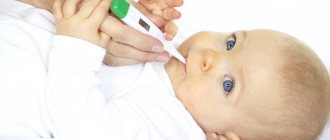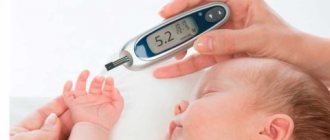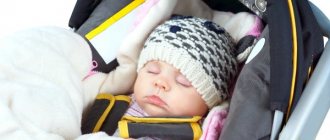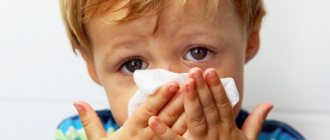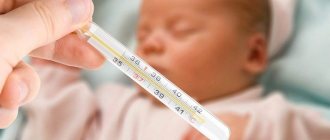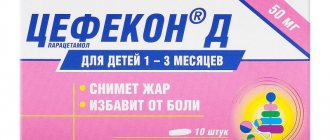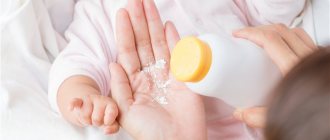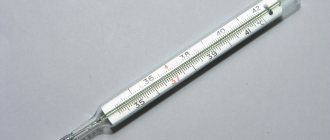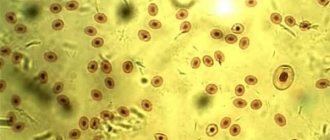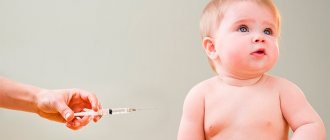How to measure the temperature under the arm
Most often, we measure the temperature under the arm with a regular mercury or electronic thermometer. Here's how to do it right:
- You should not take your temperature after eating or exercising. Wait half an hour.
- Before starting the measurement, the glass thermometer must be shaken off: the mercury column should show less than 35 °C. If the thermometer is electronic, just turn it on.
- The armpit should be dry. The sweat needs to be wiped off.
- Keep your hand pressed tightly. In order for the temperature under the armpit to become the same as inside the body, the skin must warm up, and this takes time. It is better to press the child’s shoulder yourself, for example, by picking up the baby in your arms.
- The good news: if you follow the previous rule, the mercury thermometer will take 5 minutes, not 10, as is commonly believed. Many electronic thermometers respond to temperature changes and measure as long as these changes exist. Therefore, if you do not press your hand, the temperature may change for a long time and the results will be inaccurate.
What devices can measure children's temperature?
One of the fundamental factors in determining reliable temperature readings in a child is the purchase of a thermometer. The baby should have his own personal thermometer with which he can take temperature measurements. We will find out what thermometers exist further.
- Mercury thermometer. The very first type of thermometer, which is still popular today. Its main advantage is maximum accuracy of readings. The disadvantage of a mercury thermometer is that its glass body can be easily broken and damaged by fragments. Even if the child does not get hurt, the main danger that the device hides is the release of toxic mercury vapor. To measure the temperature, you need to hold the device for at least 5 minutes, which is also a significant drawback. Despite all the shortcomings, this device even today ranks first in popularity.
- Digital Thermometer. Electronic thermometers are popular, they differ not only in cost, but also in quality. A significant disadvantage of electronic devices is the fact that they display the value with an error of 0.1-0.3 degrees. An electronic thermometer for children can be used to measure rectal temperature.
- Infrared device. The device is based on an infrared sensor, through which temperature is determined. Such thermometers have a number of advantages, among which we should highlight the high speed of data acquisition, as well as the high accuracy of the results. It is with the help of infrared devices that measurements are taken in the ears. Such devices are not recommended for use by children under 3 months. This is due to the fact that the device may display an incorrect result, which is due to the structural features of the ear canal in newborns.
- Special stripes. Another device that looks like a regular white tape. To measure, just stick the tape to the child’s forehead and then read the result. Strips give an inaccurate result, so they are used extremely rarely when the main thermometer is not at hand, for example, during a trip.
To measure your baby's body temperature, you need to decide on the choice of device. Before buying a device, you still need to find out how it is measured.
It is important to know! When choosing a device, it is important to pay attention not only to its cost, but also to the manufacturer. If it is a mercury thermometer, then the scale on it should be clearly visible. The electronic thermometer can be checked for quality of operation.
How to measure temperature rectally
This method is sometimes needed when you need to check the temperature of babies: it is difficult for them to hold their hand, it is unsafe to put something in their mouth, and not everyone has an expensive infrared sensor.
- The part of the thermometer that you will insert into the rectum should be lubricated with petroleum jelly or petroleum jelly (available at any pharmacy).
- Place the child on his side or back, bend his legs.
- Carefully insert the thermometer into the anus 1.5–2.5 cm (depending on the size of the sensor), hold the child while the measurement is taken. A mercury thermometer should be held for 2 minutes, an electronic one - for as long as written in the instructions (usually less than a minute).
- Remove the thermometer and look at the data.
- Treat your child's skin if necessary. Wash the thermometer.
How to measure ear temperature
There are special infrared thermometers for this: it is useless to stick other thermometers into the ear. Age guidelines do not measure ear temperature in children under 6 months of age because due to their developmental characteristics the results will be inaccurate. You can measure the temperature in your ear only 15 minutes after you return from the street.
Pull your ear slightly to the side and insert the thermometer probe into your ear. It takes a few seconds to measure.
Uptodate.com
Some infrared devices measure temperature on the forehead, where the artery runs through. Data from the forehead or from the ear is not as accurate Fever: First aid as with other measurements, but it is fast. But for household measurements, it is not so important what your temperature is: 38.3 or 38.5 °C.
How to read a thermometer
The measurement result depends on the accuracy of the thermometer, the correctness of the measurements and where the measurements were taken.
The temperature in the mouth is higher than under the armpit by 0.3-0.6 °C, rectal - by 0.6-1.2 °C, in the ear - up to 1.2 °C. That is, 37.5 °C is an alarming figure for measurement under the arm, but not for rectal measurement.
The norm also depends on age. In children under one year old, the rectal temperature is up to 37.7 °C (36.5–37.1 °C under the arm), and there is nothing wrong with that. The 37.1°C under the armpit that we suffer from becomes a problem as we age.
In addition, there are individual characteristics. A healthy adult's temperature ranges from 36.1 to 37.2°C under the armpit, but someone's personal normal is 36.9°C and someone else's is 36.1. The difference is big, so in an ideal world it would be nice to take your temperature for fun when you are healthy, or at least remember what the thermometer showed during your medical examination.
Most often, when a baby shows signs of illness, parents try to find out if their child has a fever. Indeed, measuring his body temperature is a convenient method of assessing the baby’s health. Of course, the absence of a rise in temperature does not at all guarantee that everything is fine with the child, because well-being must be considered comprehensively. However, an elevated temperature in a child is a clear sign that something is wrong.
Measuring the temperature of a child who was recently born is not so difficult, but for the first time it can cause some difficulties - after all, the baby cannot sit quietly for the prescribed 10 minutes with a thermometer pressed under his arm. What to do?
What factors influence body temperature?
When studying the issue of temperature deviations from the norm, you need to know what the child’s normal temperature is and what affects its changes. So, there are several factors on which it depends. These include:
- Times of Day;
- imperfect thermoregulation;
- temperature conditions of the room and environment;
- increased physical activity;
- diet and frequency of meals.
For example, in a child who is exposed to intense muscle activity, the body temperature rises by several degrees. Outdoor games and physical exercise can cause it to rise to 38 o C. In addition, high temperature can be observed when eating meat products. Thus, the composition of the food eaten directly affects the baby’s temperature.
There is no need to adjust it, since this is the normal body temperature. In the first years of life, babies are characterized by incompletely formed thermoregulatory processes, so they have a lot of energy, which they try to realize in the form of constant activity. Many parents notice increased activity in their children, since they practically do not sit in one place.
If the child has a lot of energy, then there are some problems with heat transfer. Heat, which is released in excess quantities, is released from the surface of the body through convection, as well as through evaporation during sweating and heat exchange that occurs when air is inhaled and exhaled.
The intensity of heat transfer is also determined by the difference that occurs between the temperature of the body and the environment. For example, when the baby is dressed in warm overalls, and the air temperature in the room is 24 o C, then excess heat is not released, so overheating is possible. Consequently, the standard temperature deviates by 0.4-0.6 o C. In this case, there is a risk of the child catching a cold, since the baby’s regulatory system is overstrained. Overheating is not a disease, but immediate action must be taken.
How to measure the temperature of newborns and infants?
The correct choice of a thermometer for measuring body temperature largely determines the reliability of the results obtained, so when buying a thermometer for a baby (and the baby needs its own device, separate from adults), it is worth weighing all the pros and cons.
When time counts down to seconds, special scales are used to assess the condition of a newborn in the first moments of life, allowing you to make a quick and accurate decision about how much specialized help and care the baby needs
Mercury thermometer
(maximum mercury thermometer), when used correctly, is accurate, but to a certain extent it is dangerous to use: the glass case can break and injure with fragments, and the mercury contained in it is dangerous due to its vapors. In addition, measuring temperature with such a thermometer takes a certain time.
Due to the listed features, using a mercury thermometer to measure temperature for newborns and infants is not very convenient.
Digital Thermometer
. Today there are a lot of electronic thermometers on sale that vary greatly in quality and price. And, unfortunately, many of them, due to poor quality, are not able to show the correct temperature or quickly fail. Such thermometers must be checked periodically. Please note that for the baby it is better to take a waterproof thermometer that can be washed.
The easiest way to evaluate the reliability of the readings of an electronic thermometer is to compare the results it produces with the reading of a mercury thermometer. An adult family member (!) measures his body temperature first with mercury and then with an electronic thermometer (or in reverse order) and the readings are compared.
A type of electronic thermometer is a nipple thermometer. This is a special pacifier in which a temperature sensor is inserted - the child sucks on the pacifier and at the same time the temperature in the mouth is measured.
Infrared thermometer
. An infrared thermometer measures the temperature emanating from an object using an infrared sensor. Thermometers of this type can boast very high accuracy. The most convenient way is to measure the temperature in the ear - a special attachment will not allow you to insert the thermometer too far, and you will get the result almost instantly. However, they are not recommended for children under 3 months, as they may show incorrect results due to the structural features of the newborn ear.
Many infrared thermometers can measure forehead temperature. However, this procedure does not always give accurate results, since the temperature of the forehead skin can change not only depending on how you feel, but also on environmental factors (for example, room temperature, heating of the forehead by the sun, etc.).
Strips for measuring body temperature.
This strip is applied to the forehead and highlights a number indicating the temperature of the forehead. The strips are an imprecise diagnostic tool, but they can at least roughly indicate the presence of temperature.
There are disposable varieties of such thermometers. For example, the Fevermonitor Continuous Measurement Thermometer, which allows you to attach an inconvenient small sticker to your child’s forehead that will continuously show their temperature throughout the day. This relieves parents of the need to constantly measure the temperature of a sick child.
Look at the topic - Normal temperature for a 2-year-old child
The most pleasant temperature for parents for a 2-year-old child is 36.6℃. Many are sure that this is a mandatory norm. And they get very upset when they see the numbers 37 or 35.9 on the thermometer. Apparently they don’t often watch programs with Dr. Komarovsky.
Otherwise, they would know that for a healthy baby at 2 or 2.5 years old it is quite normal for the thermometer to show from 36 to 37℃ in certain situations.
Any increase or decrease in heat transfer and heat production is an adaptive reaction of the body, a manifestation of its protective forces.
Let's find out for what reasons a child's normal temperature may change at 2 years old and how it can be returned to the “ideal” value. Of course, the latter is required only in cases of threat of hypothermia, overheating or dehydration.
What is the norm and deviations?
By the age of 2, the baby’s thermoregulation has already developed quite well. But she is still in the process of active development and therefore there are differences from adults. This manifests itself in the following:
- In 50% of babies, the measurement results in the armpits differ: in the left it is 0.2-0.5℃ higher than in the right. Probably because it is closer to the heart.
- All children from 2 years to 5 years old experience diurnal changes. At 4-5 o'clock in the afternoon the temperature is highest, at 4-5 am the lowest. And the difference is usually 0.6 to 1℃.
- For plump and active children at 2.5 years of age, the norm will be 0.2-0.4℃ higher than for thin and not very active people at the same age.
At rest at 11-14 hours 40 minutes after eating, the norm for a two-year-old usually ranges from 36.5 to 36.9℃. At 5-7 am it is usually 35.8-36.6℃. There is also a dependence on many situations that are common for a 2-year-old child.
Reasons for deviation from the norm
Reasons for temperature deviations from the norm in a healthy 2-year-old child Cause What deviations? Should it be normalized and how?
Intense muscle load:
| Increases by 0.5-2℃, up to 38℃ | Check if the child is sweating. If so, change into dry clothes and come up with a quiet activity. |
| Massage | At 0.5-1℃ | Change clothes or bathe. |
| After meal | Depending on the type of food, it is strongest after meat dishes. | Give a refreshing drink: compote, fruit drink, juice. |
| Room temperature is 24℃ or higher, the child is dressed too warmly | Up to 37.5℃ | Ventilate the room, change into lighter clothes. |
Please note that overheating, like hypothermia, puts an increased load on the body's regulatory systems. And if at this moment a microbe enters the respiratory tract, the likelihood of a cold increases greatly.
When and how to measure temperature at 2 years old?
Did you touch your forehead with your hand and it seemed hot to you? But you don’t see or hear any alarming symptoms:
- cough;
- runny nose;
- rash;
- red or watery eyes;
- cold hands and feet with a hot body;
- increased moodiness, tearfulness;
- unusual lethargy or drowsiness;
- complaints that your head or stomach hurts.
Then don't rush! Before you grab the thermometer, make sure that the room is comfortable with a temperature as close as possible to 18℃ and a humidity of 50-70%, and that the baby is not wearing a pair of extra tights and blouses. Offer your baby something to drink and play a quiet game. And only after half an hour measure the temperature.
But at the same time, consider what kind of thermometer you have and where you apply it. All usual standards are indicated for measurement with a mercury thermometer in the dry axilla. Electronic devices, especially Chinese ones, can lie shamelessly. Therefore, first test the new thermometer on your dad before and after physical activity. If before it was 36.6, and after 37.6 and higher, then the device is probably working properly.
Non-traditional measurement sites, Doctor Komarovsky reminds us, have different normal temperature values for a 2-year-old child. They differ from armpit readings:
- in the mouth – by 0.3-0.6℃;
- in the rectum and in the external auditory canal by 0.6-1.2℃.
Remember that a mercury thermometer can only measure the temperature of 2-year-old children in the armpit. Please note that even the progressive pediatrician Komarovsky prefers to use this most primitive type of thermometer, since its readings are considered the most accurate. And don’t forget that you need to hold the mercury device under your arm for at least 5 minutes.
Let's sum it up
A 2-year-old child’s body temperature should be monitored, but without fanaticism. The norm at 2 years of age already deviates less from 36.6℃ than for children at 1 year of age, but is still subject to noticeable daily fluctuations. It strongly depends on external conditions: clothing, temperature and humidity indoors and outdoors.
Deviations within 35.9-37.2℃ should not be much of a concern if your little one is cheerful, active and eats well. And if you do not see any suspicious signs indicating a cold or other illness. With the help of temperature changes, a small organism learns to adapt to heat and cold, to overly caring or indifferent parents, to this complex and changeable world.
Source: https://temperatura-u-rebenka.ru/p/norma-temperatury-u-rebyonka-v-2-goda
Where to measure the body temperature of a newborn or infant?
In both children and adults, temperature is traditionally measured in the armpit, but there are other options:
- In the armpit or inguinal fold
- Temperature in the anus (rectal temperature)
- In the ear (tympanic temperature)
- In the mouth (oral temperature)
- Forehead temperature
The most suitable measurements for newborns and infants are measurements in the mouth (requires an electronic thermometer), in the anus (in other words, in the butt) (requires an electronic thermometer) or in the ear (requires an infrared (tympanic) thermometer). Despite this, you can also measure the temperature in the armpit.
Measuring the temperature of newborns and infants in the armpit
Measuring the temperature under the arm is traditional, but has its own characteristics that you definitely need to know about.
Firstly
- if you suspect an increase in temperature, it is necessary to evaluate the body temperature, and when applying a thermometer to the armpit, the thermometer will measure the temperature of the skin surface. Therefore, to obtain correct results, the position of the hand immediately before measuring the temperature is extremely important:
- If the hands were raised, the measurement will show a temperature lower than the real one;
- If the hand was pressed to the body for at least 5 minutes, the temperature measured in the armpit will correspond to the real body temperature.
Based on this, in order to measure the temperature correctly, you need to press your hand to your body for several minutes before placing the thermometer under your arm. To measure temperature with a mercury thermometer, it is enough to hold the thermometer for 5 minutes.
Secondly
– the skin in the armpit must be dry before placing the thermometer there. Moisture from sweat can also cause unreliable results.
Regardless of whether you take measurements with a mercury or electronic thermometer, you must keep the child’s hand tightly pressed to the body throughout the measurement, and be extremely careful with the mercury device. The tip of the thermometer should be exactly under the armpit, and not stick out or rest against the folds of clothing.
Measuring the temperature of newborns and infants in the anus
For this type of measurement, the tip of the thermometer, pre-lubricated with Vaseline, is inserted shallowly into the baby’s anus. The child's legs must be kept bent. This type of measurement is not recommended to be carried out with a mercury thermometer due to the risk of damage.
Measuring the temperature of a newborn or infant in the ear
To measure tympanic temperature, only infrared thermometers are used, which assess the temperature of the eardrum in the child’s ear. The infrared thermometer is fast (only a couple of seconds), safe and accurate. Under no circumstances should you put a mercury or electronic thermometer into your ear.
Measuring the temperature of a newborn or infant in the mouth
The already mentioned thermal pacifier will help parents with this. Under no circumstances should you put a mercury thermometer into your baby’s mouth.
Measuring the temperature of a newborn or infant on the forehead
This type of measurement is not very accurate. Can be done with an infrared thermometer or strips to measure body temperature.
What body temperature is considered normal for a baby: indicators by month up to a year
New parents often begin to panic when they see a reading above 36.6 on their baby’s thermometer.
Pediatricians have developed standards regulating indicators at different life stages of baby development.
In order not to panic prematurely, parents are advised to familiarize themselves with these standards.
Depending on the measurement method, the indicators will vary: rectal temperature and armpit thermometer indicators will be different.
Recommendations from pediatricians, as well as the opinion of a famous doctor, will help mom monitor the numbers on the thermometer.
Normal body temperature in infants by month up to one year
It is worth noting that the body temperature of infants changes according to age.
Premature babies are often exposed to changes in ambient temperature - this is affected by low metabolic activity, low body weight and imperfect thermoregulation.
Doctors also note that indicators may vary at certain times of the day.
In the early morning, the thermometer will show lower numbers than when measured at lunchtime.
Consider the normal temperature for children under one year of age:
- After leaving the womb, the indicators will be equal to the parameters of the mother’s body.
- In the first hours, the readings drop slightly by 1.5-2 degrees, and after 6 hours stabilization is observed - from 36.5 to 36.8 degrees.
- To avoid creating unnecessary anxiety, pediatricians spent a lot of time monitoring the babies.
They concluded that a reading between 36.4 and 37.4 is considered normal. This temperature persists from 1 month until the age of 2 years. - Sometimes parameters may increase in infants. At 2 months this is associated with colic, and in older children - with the eruption of the first teeth.
If in the 3rd month the thermometer readings exceeded 38 degrees, but there is no disease, the reason lies in overheating, a reaction to the vaccine, as well as allergies.
What should the temperature be in the armpit?
It is recommended for a healthy baby to measure the temperature in 3 ways - rectally, orally and through the armpit.
It is advisable for mom to record all indicators in order to track deviations from the norm. Such monitoring will help to understand when the infection has settled and the baby has become ill.
Let's consider what the temperature of this zone should be:
- When measured in the groin fold or armpit, it should be between 36 and 37.2 degrees.
- Parameters more familiar to adults are established closer to the first year of a baby’s life.
- Indicators can be measured with an electronic, mercury or non-contact infrared thermometer.
- Today, parents prefer to choose a non-contact or electronic thermometer so that the baby does not become capricious, and the measurement is quick and painless.
- To obtain clear indicators, it is recommended to sit the baby on your lap, insert the thermometer into the armpit, and fix the baby’s hand straight.
- To distract the child, you can tell him a story, show him an interesting object - the main thing is not to move the pen.
- When measuring with a mercury thermometer, you must wait 5 to 7 minutes.
- When measuring with an electronic thermometer, the device itself will tell you when it’s time to remove it.
Having become familiar with what is considered normal temperature for a baby, you don’t have to worry prematurely and don’t panic, thinking that the baby is sick.
Important! It is recommended to measure parameters in the morning and evening in a quiet environment. When measuring too much, babies develop a negative reaction.
To keep the indicators normal, monitor the air temperature in the room, dress your baby according to the rules and cover him with linen made from natural materials.
Rectal temperature
The usual method of measuring in the armpit is considered the most accessible and painless, but pediatricians sometimes recommend taking measurements rectally.
This temperature allows you to find out if there are health problems and seek medical help in time.
Note! Rectal readings must be taken in the first months of the baby’s life.
The best way to obtain the necessary information is to take measurements while the baby sleeps.
Several features and indicators of what the rectal temperature should be:
| Question | Description |
| How to measure? | To make the procedure quick and painless, it is recommended to place the baby on your lap and insert a thermometer into the anus. For children over 5 months of age, this method is no longer relevant. |
| How to measure? | There is no special device for measurement, so doctors recommend using a standard electronic thermometer. It is inserted into the anus without any problems, and after 1 minute you can observe the finished parameters. The device must be supported with your hands so that it does not fall out |
| What is the norm? | Indicators range from 36.4 to 37.5 degrees |
Normal according to Dr. Komarovsky
The famous doctor Oleg Komarovsky claims that the thermoregulation of the baby’s body is still far from perfect.
Therefore, indicators tend to change during the day, which causes confusion for the mother.
To prevent this from happening, it is recommended to maintain optimal air conditions in the room and monitor the baby’s clothes.
Komarovsky says that it makes no sense to bring down a slightly elevated temperature in a baby - using pills will only worsen the baby’s immunity.
Let's consider the pediatrician's opinion regarding normal temperature:
- To understand the optimal parameters for your baby, measure the temperature for several days when the baby is calm and cheerful.
- An indicator of up to 37.4 degrees is considered normal, according to Komarovsky.
- 37 degrees is also considered the norm at 4 months.
- If a baby's temperature increases to 38.2 before the age of 6 months, pay attention to his behavior: if there are whims, the baby could get sick.
Careful monitoring of parameters over several days will let the mother know when to worry about an elevated temperature, and when there is no reason to worry.
Source: https://LadyVapm.com/baby/normalnaya-temperatura-tela-grudnichka.html
Normal body temperature
Despite the well-known “standard” temperature – 36.6 °C – not everything is so simple in this matter.
For example, body temperature standards vary depending on the patient's age.
It is worth noting that it is necessary to take a comprehensive approach to assessing the baby’s condition - if a child at a normal temperature exhibits lethargy, poor appetite and other signs of deterioration in health, it is necessary to consult a doctor.
The norms of temperature measured in different parts of the body also differ:
- The temperature in the anus is 0.6-1.2 °C higher than the temperature under the armpit;
- The temperature in the mouth is 0.3-0.6 °C higher than the temperature under the armpit;
- The temperature in the ear is 0.6 - 1.2 °C higher than the temperature under the armpit.
Thus, if an infrared thermometer shows a temperature in the ear slightly exceeding 37 ° C, then this is completely normal.
WHAT IS THIS?
Fever is an increase in normal body temperature. The norm ranges from 36.5 to 37.5 ºC. Typically, fever is a reaction of the immune defense system to an attack by an infectious pathogen (bacteria or viruses) or to any foreign object. Therefore, it is a beneficial natural reaction that helps us get better.
HOW TO MEASURE?
The actual body temperature is the so-called “core temperature”, in other words, the temperature of the internal organs. The ideal location for measurement is the pulmonary artery, but this method is inconvenient and invasive.
Temperature can be measured in different parts of the body both internally (orally, rectally, in the ear canal) and externally (in the armpit, forehead and temples). On average, the temperature in the armpit is half a degree lower than in the rectum, mouth or ear.
Moreover, body temperature can:
- fluctuate throughout the day (lower in the morning and higher in the evening);
- vary (each person has their own normal body temperature);
- vary depending on where on the body it was measured. Also, the temperature may not be the same on the left and right sides of the body.
Various instruments (infrared or electronic) are used to measure temperature:
Causes of fever in infants, other than illness
Prolonged crying or overexcitement.
As already noted, a child’s thermoregulation system is unstable in the first months of life, therefore, when a child is overexcited or cries for a long time, he may overheat, resulting in a slight increase in body temperature.
Colic
. The cause of an increase in body temperature in a child up to 1 month can be colic or gas in the tummy - this is a common occurrence. A sign of this may be a bloated stomach.
General overheating.
When the child is in a hot room or dressed too warmly, exposure to the sun, or prolonged exposure to a hot bath.
An increase in temperature in babies under one year old can be expected when they are teething.
, or when the child was vaccinated.
Fever may be due to an allergic reaction
for any irritating factors.
It is generally accepted that a person's normal temperature is considered to be no higher than 36.6 degrees. But it should be borne in mind that this is the normal temperature for an adult, and for a child, temperature fluctuations can be very different, and this is also not a pathology.
In order not to make a mistake when measuring a child’s temperature, you must first know the normal temperature for a child of different ages. For example, in a newborn it is almost always higher than the level set by doctors (36.6). It can range from 36.8-37.3, and this is considered completely normal. In premature babies, on the contrary, it can drop as much as 35.5 degrees. This is due to the immaturity of their circulatory system.
In addition, body temperature can change depending on the ambient temperature. For example, in summer, in hot weather, it is slightly higher than in winter. True, the fluctuations are practically insignificant, but they still exist.
An important factor is the method of measuring temperature. It can be performed orally (thermometer in the mouth), rectally (in the rectum), in the armpit and in the ear. For example, if you measure a child's temperature rectally, it will be about one degree higher than the temperature in the armpit, and if you measure it orally, then by 0.5 degrees. Therefore, this should be taken into account when measuring temperature.
You should be aware that the normal temperature in children can fluctuate throughout the day. For example, in the morning it is slightly lower than in the afternoon, and in the afternoon it is lower than in the evening. Therefore, if you see that when you measure your temperature in the evening, it has become higher than when you measured it in the morning, you should not immediately get scared and call a doctor. This is also considered completely normal.
The normal temperature in children is largely influenced by the constitutional characteristics of the body. In two children of the same age, it can be either lower or higher, and both levels of temperature are considered completely normal. In addition, heredity may have an influence. If the parents of a child consider the normal temperature to be, say, 35.8 degrees, then it is quite possible that for their child it can vary within the same limits.
In addition to all this, complications during childbirth can affect fluctuations in body temperature. For example, if various methods of delivery were used at the birth of a child, then it is quite possible that the baby’s temperature will constantly remain below the established norm.
The temperature level in children is largely influenced by their emotional state. Usually in children with an unstable nervous system it is an order of magnitude higher than in calm children. In addition, the temperature may rise due to excessive stress of the baby, for example, when he starts crying or strains hard due to constipation. Therefore, it is not recommended to measure a child’s temperature at a time when he is restless or crying. After the child calms down, the temperature will drop back to normal.
Every mother strives to ensure that her child is strong and healthy. The first sign that the baby is unwell appears in the form of an increase in body temperature. In children under one year old, body temperature readings range from 36.2 to 37.4 degrees, which is normal. Only by the age of one year are body temperature readings established at a normal level, which is 36.6-36.8 degrees. Almost every mother is faced with a situation where the thermometer reading of a one-year-old baby is above 37 degrees. Whether this is normal or not, we will find out in more detail.
Temperature measurement axillary (in the armpit):
BEHIND:
- Convenient and non-invasive measurement method.
AGAINST:
- Takes a few minutes.
- Patient assistance is required for proper placement of the thermometer.
- Can detect fluctuations in core body temperature after only 1 hour.
External factors can affect body temperature. Be careful when placing the thermometer in the armpit. Make sure your armpits are dry and hold your child while they take their temperature.
To make the process easier, use thermometers with specially adapted sensors for children or quick-release thermometers (60 seconds). Remember, thermometers that measure axillary temperature for less than 60 seconds cannot be considered reliable.
Measuring temperature rectally (in the rectum):
Using an electronic thermometer:
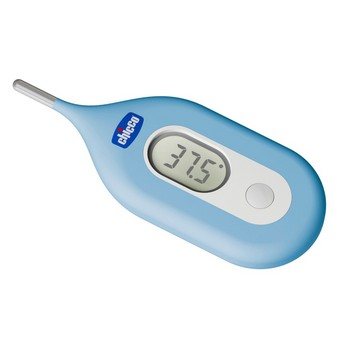
BEHIND:
- Ideal for babies.
- Fast.
- Reliable.
AGAINST:
- May be a little annoying for baby.
- Risk of local (local) damage.
- Inconvenient.
- Not suitable in case of diarrhea or inflammation of the rectum.
- Can detect fluctuations in core body temperature after 1-5 hours.
Lubricate the tip of the thermometer with Vaseline or olive oil. When taking the temperature, try to hold your baby and do not place him on his back. The result cannot be considered reliable for diarrhea or inflammation of the rectum.
When measuring temperature rectally, the indicator may be half a degree higher compared to the axillary method. To make the process easier, use thermometers specifically designed for taking children's rectal temperature (short flexible tip).
Body temperature 37.2 without accompanying symptoms in children
The normal temperature for both adults and children is considered to be a thermometer reading of 36.6° C. This indicator may vary slightly in one direction or another depending on several physiological processes, in particular thermoregulation. For example, newborn children still have an imperfect nervous system, which affects the thermoregulation system. Therefore, often when measuring temperature, the thermometer reading may stop at a mark above 37°C, which is considered quite normal in medicine. It should be noted that the body of newborn children quickly reacts to any changes in the environment, which immediately affects their body temperature.
Important! This explains the fact that an infant should not be wrapped, as all pediatricians in the world strongly advise. The process of thermoregulation is normalized only by the age of three months, which is necessary for each parent to know.
It is also worth noting that the cause of elevated temperature is nothing more than a protective reaction of the body, which manifests itself at the slightest suspicion of the penetration of an irritant of an infectious disease - there is an active release of interferon, which is considered a powerful antiviral substance. For example, if a child coughs, and after measuring the temperature the indicator stops at 37 ° C or higher, then most likely the infection begins to affect the upper respiratory tract. When the body temperature is 37 degrees or higher, accompanied by vomiting, the infection has entered the intestines. In these cases, you should immediately call a doctor who, after examination, will prescribe the correct treatment.
Diarrhea and a thermometer reading of 37° C in children under one year old can often be caused by teething. Exactly the same symptoms can manifest themselves with an intestinal infection, especially when the child is over 5 years old, when teething cannot be discussed.
Measuring body temperature on the forehead or temples
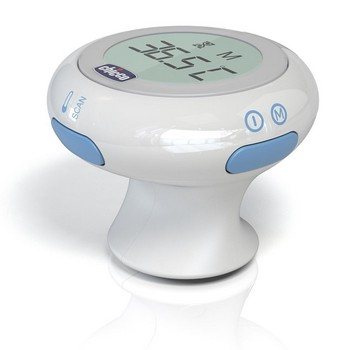
Using an infrared thermometer.
Two measurement methods are used: contact and non-contact.
Usually, when measuring temperature at the temples, a contact method is used, and at the forehead, a non-contact method is used.
BEHIND:
- Comfortable.
- Very fast.
- Non-invasive.
- Reliable indicators of core body temperature (a few millimeters below the temporal region is the temporal artery, which carries blood from the heart to the brain).
AGAINST:
- The influence of external factors and problems with blood circulation.
- The thermometer must be used correctly to get reliable results.
Allow the thermometer to adapt to the temperature of the child's environment for 20-25 minutes. If the child comes from outside, wait at least 5 minutes before taking the temperature. To understand whether a child has a fever, compare the reading on the thermometer with the baby’s normal body temperature, measured with the same thermometer. On average, the temperature in the temporal region is higher than in the armpit.
Take temperature measurements at the same temple to obtain valid and reliable readings that can be analyzed and compared.
What causes an increase in body temperature in a child?
Everyone knows that normal body temperature is 36.6 degrees. This is an ideal indicator that is rare, especially in children under one year old. Slightly elevated thermometer readings do not mean that the child is developing a disease. Often the main factor influencing an increase in body temperature in a child is illness. The immune system begins to react with foreign bacteria, against which the disease develops. As a result of this reaction, energy is released, which manifests itself in the form of an increase in readings on the thermometer.
It is important to know! You cannot lower the temperature, the readings of which do not exceed 38 degrees in children, because in this way the bacteria overcoming the body have the opportunity to further spread.
Many mothers simply do not understand the principle of increasing temperature, so already at 37.5 they rush to put antipyretic suppositories or give syrups. Disease is the main factor on the basis of which a high thermometer value is observed. In addition to this, there are other factors that influence the process of temperature rise. These factors include:
- Overheating of the body.
- Psychological condition.
- Great physical overload, but for children there is enough activity during play for the thermometer to show a value above 37 degrees.
- Physiological characteristics of the body. Premature babies often have a low temperature ranging from 36 to 36.4 degrees.
In addition, it is worth taking into account such a factor as the time when the measurement is made. After all, in the evening the thermometer will show a higher value than in the morning. If the measurement is taken after sleep, the readings will be more reliable than when the baby is awake or breastfeeding. When measuring, it is necessary to take into account another factor such as the device itself. The most objective today are mercury thermometers, even in comparison with modern electronic devices.
Everyone is accustomed to measuring temperature under the arm, although in addition there are other places to measure it, such as:
- large intestine, for which the thermometer should be inserted through the anus;
- oral cavity;
- ear canal.
If an adult can measure the temperature under the armpit to find out whether he is sick or not, then for babies it will be necessary to take several measurements in different ways.
Temperature measurement in the ear canal
Using an Infrared Thermometer.
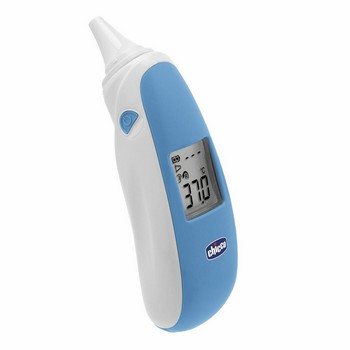
BEHIND:
- Very fast.
- Comfortable.
- A reliable indicator of core body temperature (the eardrum has the same blood flow as the hypothalamus).
AGAINST:
- Good practice is required.
- The correct placement of the sensor affects the reading (if the sensor is not accurately aimed at the eardrum, there is a risk of getting lower readings).
- The influence of local factors (otitis media, earwax).
For an accurate measurement, move the earpiece back slightly to straighten the ear canal and very carefully insert the sensor. The goal is to obtain the most accurate data.
Children under 2 years old need to gently pull the ear back.
Children over 2 years old and adults need to pull the ear up and back.
Measure your child's body temperature when he feels well to determine normal and recognize hyperthermia later. Remember that you need to measure your temperature under the same conditions, using the same thermometer, body area, method and time.
Body temperature may be higher or lower after drinking a hot or cold drink, running, taking a bath or changing location (from a hot place to a cold place), or prolonged crying. In these cases the result cannot be relied upon.
Take your temperature in the morning after waking up or late at night. Do not take your temperature during digestion or in the evening. She will be taller.
At elevated temperatures, let your child drink more liquid at room temperature (water, tea, chamomile infusion). Don't cover it too much, feed it small portions and easily digestible food. Continue breastfeeding.
The child should take antipyretic drugs only with a doctor's prescription and when the temperature measured rectally is more than 38.5 ºC (38 ºC in the armpit). And also if the child is very depressed.
Otitis media, or inflammation of the ear canals, is a disease that often occurs in childhood. Doctors say that by the age of three, 90% of children experience this disease at least once. Otitis has a number of characteristic symptoms, one of them is fever, which is very worrying for parents of sick children. How long does the fever last for this disease and how to alleviate the child’s condition?
An infectious-inflammatory process in the ear canal occurs as a complication of viral and bacterial infections of the respiratory system and nasopharynx. The causative agents of the disease are usually adenoviruses, influenza viruses, Haemophilus influenzae and pneumococci
. Due to the fact that the functioning of the immune system in childhood is not very well established, otitis often accompanies diseases characterized by difficulty in nasal breathing - sore throat, sinusitis, rhinitis, laryngitis, etc.
In infants, the reason for the development of the disease lies in the special structure of the hearing organs. A small tube, called the Eustachian tube, passes close to the pharynx in infants, which allows pathogenic microorganisms to easily penetrate the ear. In addition, children under the age of one year are constantly in a horizontal position, which is why mucus flows into the Eustachian tube, causing inflammatory processes. With age, the auditory tube becomes longer, narrower and located at a greater angle to the pharynx, as a result of which mucous secretions practically do not enter the ears.
Important!
Otitis has a number of characteristic signs by which it is quite easy to recognize the disease: ear pain, weakness, dyspeptic symptoms (nausea, vomiting) and increased body temperature, but in general the baby’s condition depends on the form of the disease.
Table. Main forms of otitis.
| Form of otitis | Symptoms |
| Lethargy and apathy, constant crying and irritability in infants, the appearance of purulent discharge from the ears, increased body temperature. Suppurative otitis is characterized by severe hyperthermia (from 38 degrees and above), and the temperature drops only for a short time, after which it rises again. | |
| Severe pain in the ear, which radiates to the head and teeth, decreased hearing, deterioration of general condition. Fever is one of the symptoms of this form of otitis, but the numbers on the thermometer depend on the functioning of the immune system. | |
| Gradual hearing loss, tinnitus. In most cases, exudative otitis media occurs without hyperthermia; sometimes low-grade fever is possible (not higher than 37-37.5 degrees). |
In addition to the above classification, otitis media is divided according to the localization of the inflammatory process, which can occur in the outer or middle ear, in acute or chronic form, etc.
On a note!
The most difficult to diagnose is exudative otitis media, since it is practically asymptomatic, and children and parents practically do not pay attention to slight hearing loss and tinnitus.
It also causes some difficulties in identifying the disease in infants who cannot talk about their condition. Signs of otitis media in this case include moodiness and restlessness, breast refusal, constant crying for no apparent reason and hearing loss (the child does not respond to the parents’ voices or extraneous sounds). You can diagnose the disease in infants using a simple test - just lightly press on a small protrusion (tragus) next to the baby's ear. If the child cries a lot after this, it means that this movement caused an increase in pain, which is typical for otitis media.
A child has a high temperature - Komarovsky, what to do?
An increase in body temperature is observed in most diseases in childhood. And this is always a reason for panic for parents, especially if the child is still very small. The temperature can rise even with changing weather, fatigue or stress. In any case, it is important to know the cause of the symptom to take action.
Child's temperature
The younger the child, the more dangerous the temperature is for him. It cannot be determined with a kiss on the forehead; in infants it is better to measure it with a pacifier thermometer.
You must follow the following rules:
- measure at least 3 times during the day,
- measure not when the child is active, when he is crying or playing, taking a bath or wrapped up warmly, but in a calm state, lying down, at a normal temperature in the room.
When measuring temperature orally, it is better to do this on an empty stomach or an hour after eating.
Few adults know that a child’s normal temperature is not necessarily 36.6°C. In infants under one year of age, it is normally slightly higher than in older children. The normal axillary temperature for a child under 1 year of age is considered to be less than +37.4°C, and for a child over 12 months – less than +37°C.
It is usually recommended to bring down febrile temperature indicators, i.e. more than 38°C if the child does not tolerate it well.
In some cases, medications are also needed for low-grade symptoms:
- less than 2 months old
- if there are heart pathologies,
- with convulsive readiness,
- when overheated.
Doctor Komarovsky's opinion
Many parents believe that fever is not a serious thing, but you need to give your baby a pill and everything will go away. This is where many mistakes lie: they wrap up the child, warm the room, do not allow the baby to move, and try to feed him to preserve strength in the fight against the disease. All actions are absolutely wrong. You need to forget about food until the child himself wants it.
You should provide your baby with several things:
- give enough drink,
- do not overheat or overcool the child,
- the room temperature should not be higher than 18-20 degrees,
- the air must be clean and humidified.
The temperature should normalize on the 4th day; on the 7th day it should not be there at all.
High temperature in a child: Komarovsky
An increase in body temperature is typical not only with ARVI, but also with any childhood infection. At the same time, the body produces substances that protect the body from pathogens.
For example, many people know this substance - it is the protein interferon, which has antiviral activity. Its amount has a direct relationship with body temperature, that is, the higher the temperature, the more interferon.
This is why many people notice an increase in temperature at the beginning of interferon treatment.
Since interferon increases to a maximum on days 2-3 after the temperature rises, most ARVIs end safely on the third day of illness.
Another option is “very smart” parents (they quickly “brought down the temperature” and are happy) or a weakened immune system in a child who cannot begin the fight against pathogens with a rise in temperature.
Here there will be little interferon and it will not be possible to cure ARVI in 3 days. Antibodies will fight the viruses and the duration of the illness will extend to 7 days.
This is also an answer to the popular wisdom that “unloved” children are sick for 3 days, and “favorite” children are sick for a week.
The main thing for a child with fever is to do everything to ensure that the body has the opportunity to lose heat.
Two mandatory actions: drink plenty of fluids so that you have something to sweat, cool air in the room (optimally 18 -20 degrees). If these conditions are met, there is a high probability that the body will cope with the temperature itself.
Tea with raspberries dramatically increases the formation of sweat. It is many times more effective than drugs. But it should not be given to children under one year of age.
If the baby is capricious and chooses food, then it is better to drink anything (mineral water, herbal infusions, tea, viburnum, rose hips, currants, etc.) than not drink at all.
Any drink will be absorbed into the blood only when its temperature is equal to the temperature of the stomach: given cold, it will not be absorbed until it warms up, warm, until it cools down.
Reducing the temperature
Of the antipyretic drugs, only 2 drugs are used for children: Paracetamol (syn. Dofalgan, Panadol, Calpol, Mexalen, Dolomol, Efferalgan, Tylenol) and Ibuprofen. Other drugs cannot be given. The higher the temperature, the thinner the medicine should be.
It is useless to use suppositories; at readings above 38.5°C, it will not be absorbed.
Suppositories should be replaced with syrups or solutions - they are absorbed immediately. The tablet will also not help; it will lie peacefully on the wall of the stomach. The temperature of the medicine should be equal to body temperature, i.e. not lower than 37°C. Before giving, you need to warm the bottle in your hands.
Recommended doses:
- Paracetamol 15 mg per kg of weight, maximum single dose 60 mg/kg. You can only use it 4 times a day, no more often! Interval 4 hours. Paracetamol should not be given for more than 3 days.
- Ibuprofen – 10 mg/kg body weight, maximum 25-30 mg/kg. You can give no more than 3 times a day, i.e. interval 6 hours.
To know how much medicine is needed, parents must calculate it in advance, even before the baby gets sick. Because during the illness of a febrile child, parents will not have the time or thought to give the correct dose. You will do this approximately, which should not be allowed.
You can fight the temperature on your own for the first 3 days. If there is no improvement, you should call a doctor on day 4.
The effect of the medicine is a decrease of half a degree after half an hour, and not to 36.6 ° C.
Self-use of paracetamol or ibuprofen is a temporary measure until a doctor arrives. They do not treat, but only reduce the severity of hyperthermia.
Why does the temperature rise with otitis media?
An increase in temperature is a natural reaction of the body to inflammatory and infectious processes in the body. The numbers on the thermometer for this disease depend on the clinical course, the state of immunity and the age of the child - infants tolerate the disease much more difficult than older children.
Most often, a high temperature occurs with a purulent form of otitis, and the fever lasts until the pus comes out of the ear, on its own or after appropriate medical procedures. The duration of the hyperthermic stage can be from 3 to 7 days, after which the temperature drops to normal limits.
Another reason for the increase in temperature during otitis is complications of the disease that develop as a result of improper treatment. The most dangerous consequences of ear inflammation are mastoiditis (damage to the tissue of the mastoid process, accompanied by the development of osteomyelitis), meningitis and otogenic sepsis. The development of complications is characterized by the following clinical picture: the patient’s condition improves for several days, after which ear pain, fever and other manifestations of the disease reappear.
Reasons for deviation from the norm
If an adult’s body temperature rises due to infections, colds or inflammatory processes, then a baby has many more reasons for deviations from the norm.
At elevated temperatures
It can be:
- Eating. The baby’s body spends a lot of strength and energy on digesting food. The baby makes an effort to get milk from the breast or formula from the bottle. A slightly elevated temperature is possible during meals or for 1-2 hours after;
- Overheat. The child's body becomes very hot when he is in a hot, stuffy room. Heat exchange is not established, so the temperature can rise quickly if the baby is wrapped up too tightly, he is in a diaper for a long time, or his stay in the open sun is prolonged;
- Vaccination. Some types of vaccinations, especially DTP, sometimes cause a significant increase - up to 38.5-39. Usually the doctor warns about possible reactions;
- Teething. This is one of the most common reasons for an increase in body temperature in newborns to 38-38.2 degrees due to swelling and inflammation of the gums. The condition is accompanied by lethargy, moodiness, and loss of appetite. In some cases, a runny nose and frequent bowel movements may occur. Against the backdrop of a weakened body, the risk of a cold increases, and then an elevated temperature will be a sign of illness, not teething. In this case, a cough, runny nose, redness and sore throat appear;
- Thirst and dehydration. It is important that the baby receives enough fluid, especially in the heat and when bottle-fed. In children, water deficiency in the body occurs much faster than in adults, which is very dangerous.
Can otitis media occur without fever?
Otitis is not always accompanied by an increase in temperature - there are several forms of the disease for which fever is not characteristic. Most often, this course of the disease is observed during an inflammatory process caused not by infectious infection, but by mechanical damage to the skin of the ear canal. A wound forms at the site of damage, causing a burning sensation and pain, which intensifies if microbes enter the wound, and an abscess forms in its place.
In addition, if ear pain occurs without hyperthermia and other general symptoms, a differential diagnosis of otitis should be made with otomycosis (damage to the structures of the hearing organs by fungal microorganisms), eczema of the ear canal. Fungal ear infections can be distinguished from inflammatory processes by the presence of itching, which is characteristic of fungal infections. There is no increase in temperature in diffuse external otitis and atypical course of the inflammatory process.
In what cases should you consult a doctor immediately?
Temperature with otitis media causes a lot of discomfort for both the baby and his parents. In any case, this symptom requires contacting a doctor, but in some situations the child needs medical attention immediately. You need to call an ambulance when the temperature is high:
- observed in a child under six months of age;
- is not affected by conventional antipyretic drugs;
- accompanied by dyspeptic disorders (nausea, vomiting, diarrhea) or skin rash, severe headache, weakness.
The above signs may indicate not only otitis media, but also other dangerous diseases, so it is best to consult a doctor as soon as possible.
Treatment of otitis media with fever
It is recommended to lower the temperature only in cases where it exceeds 38-38.5, and in children suffering from convulsive syndrome, cardiovascular disorders or other concomitant diseases, the permissible figures are 37-37.5. If the fever is not too severe and the child feels well, the use of antipyretics is not recommended in order to give the body the opportunity to fight the infection on its own. In order to bring down the temperature, it is better to use drugs containing ibuprofen or paracetamol in the appropriate dosage - they will not only eliminate the fever, but also reduce pain in the ear.
The main component of the treatment of otitis accompanied by fever is antibacterial agents, which can be local (used at the site of inflammation) or systemic. In cases of mild disease - the disease is accompanied only by pain in the ears and low-grade fever - the fight against the pathological process is usually limited to the use of local drugs. If such treatments are ineffective, you should switch to systemic therapy.
For purulent otitis, the use of antibiotics (Amoxicillin, Flemoxin Solutab), which are prescribed by a doctor, is indicated. An increase in temperature during otitis plays another important role - it helps to evaluate the effectiveness of the chosen treatment regimen. With proper therapy, an improvement in condition and a decrease in temperature is observed within the first day. If the fever remains unchanged for several days, it is necessary to select other drugs. With proper treatment, catarrhal otitis takes an average of a week, purulent otitis – in two weeks.
General principles of treatment of otitis media in children
In order to get rid of the disease and its symptoms as soon as possible, it is necessary to adhere to the general rules for the treatment of ear diseases.
- Antibiotics for oral administration are prescribed exclusively by the attending physician. As a rule, therapy includes cephalosporins and penicillins, and in the presence of allergies, macrolides.
- It is not advisable to use drops containing antibiotics in the first stages of the disease - drugs with an analgesic and decongestant effect are better suited. They are used in the acute phase of the disease in the presence of perforation, as well as in cases of chronic otitis.
- In case of acute otitis media, it is recommended to instill vasoconstrictor drops for rhinitis into the child’s nasal passages, which will restore normal communication between the nasal passages and the middle ear.
- If the child does not have a fever or purulent discharge from the ears, warming compresses can be applied. They are not placed on the auricle itself, but around it - a hole is made for the ear in a piece of bandage or gauze folded several times, after which the fabric is moistened in diluted alcohol or vodka, and a compress is applied to one side of the head. It is covered with polyethylene on top, insulated with cotton wool and secured with a scarf. The duration of the procedure is at least two hours.
- You can warm sore ears using a medical reflector with a blue lamp or a bag of salt, but such activities can also be carried out only in the absence of fever and pus.
- Using traditional recipes to treat otitis in children, especially without consulting a doctor, is strictly not recommended - self-medication can complicate the course of the disease and provoke serious complications.
You should not bathe a child with otitis media - it is better to rub it with warm water. Meals should include light but nutritious meals with sufficient vitamins. Walking is allowed only after the temperature has returned to normal, and ear pain and purulent discharge have disappeared, and the baby needs to wear a hat while he is outside.
Prevention of otitis
The development of otitis media in children can be prevented with simple preventive measures. First of all, it is necessary to avoid colds and increase immunity: take vitamin complexes, eat fresh vegetables and fruits, and harden the child. If the baby does get sick with a cold or acute respiratory viral infection, treatment should be carried out in a timely manner and under the supervision of a doctor. Under no circumstances should you clean out earwax with objects not intended for this purpose - pins, matches, bobby pins. Children under three years of age require constant adult supervision - children of this age often insert foreign objects into their ears, as a result of which purulent otitis media develops.
0
